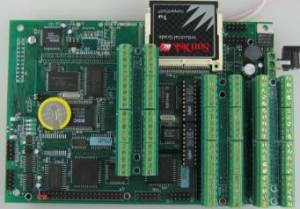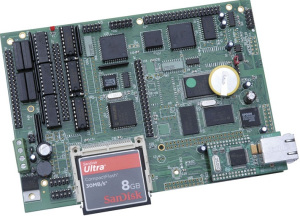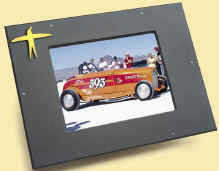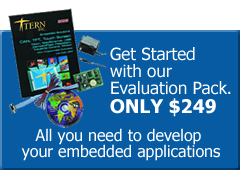The SmartTFT (ST) is a low cost industrial controller flexible enough for usage in a wide range of applications.
It has enough power to drive the most intensive industrial control applications, while also integrating the newest display technology. Those with premium graphic requirements will benefit from the ultra-bright, wide viewing angle active TFT color display.
Whether you’re designing an OEM application, or just looking for a few units for prototyping purposes, the highly flexible and ultra powerful Smart-TFT might just be the answer
LCD Display
The SmartTFT’s display interface is similar (and compatible) to that of the SmartLCD-Color. It features a LCD controller (S1D13705, EPSON) with an internal 80KB image buffer mapped directly to memory, and can support a wide range of QVGA color graphic TFT/LCD with 320×240 pixels.
A touch screen controller (ADS7846) supports 4-wire resistive touch screen. The touch screen is interrupt-driven and highly accurate, capable of distinguishing presses down to a few pixels.All components are installed on single PCB, which can be mounted on the backside of a QVGA LCD for easy integration into user applications.
Comprehensive, user-friendly software libraries and samples are provided. User can easily design their custom functions keys, text, logo, and graphics. Supported by the CF file system, 20 impressive color images can be displayed per second via DMA transfer.
In theory, the SmartTFT can be used with a number of display options. For standard orders, we offer two options (5.7″) from Kyocera: an active TFT display (> 400 nits), and the still excellent passive color G50 display (supplied with the SmartLCD-Color). For OEM customers, it may be possible to integrate with LCD panels for cost savings, and/or different mechanical or performance specifications. The integrated LCDs are provided with CCFL backlighting and alumnium bezel for each mounting.
More details on Kyocera’s LCD displays available here.
Controller
The SmartTFT is a tremendously powerful controller even without the LCD display.
The 40 MHz 16-bit 186 CPU with 256KW flash, 256 KW battery-backed SRAM is fully C/C++ programmable. Standard processor features are automatically provided; 3 16-bit timers, external interrupts, numerous digital I/O lines. Four RS232 serial ports are provided by default on-board. One serial port can be optionally configured as RS485/422. An additional optional SCC2691 UART can provide a 5th RS-232/485 port.
The SmartTFT also provides three additional 16-bit peripheral counters (71054, NEC), capable of counting up to 10MHz. An optional 10-baseT Ethernet LAN controller (CS8900) can be installed. The standard TERN software stack library is available, supporting network protocols such as ARP, DHCP, UDP, ICMP, and of course TCP over the Ethernet network.
The integrated CompactFlash port is especially useful in a LCD display environment, useful for storing images and other display material. We offer a FAT16-compatible filesystem library, useful for easy handling of data.
The on-board switching regulator (LM2575) allows 8-30V unregulated DC power input without over heating. It is possible to stack or to use two STs with one used to manage display, one for high speed I/O. They can communicate via J2 I/O pins or a serial port.
 Industrial I/O
Industrial I/O
Customers consider the ST for industrial environments will appreciate the 16-bit ADC/DACs, opto-couplers, relays, quadrature decoders, and 4-20 mA drivers available on-board. All of these features can be installed on the same PCB at the same time, no additional modules required.
I/O signals can be accessed via up to four W40s to provide 160 field removable industrial screw terminals, as shown in the picture below:
There are a total of 20+ TTL I/Os, 4 mechanical relays (contact rating of 200V, 0.5 Amp), 12 opto-couplers capable of interfacing high voltage inputs with opto isolation. 20+ solenoid drivers are capable of sinking or sourcing 350 mA at up to 50V each. 14 of the solenoid drivers can be hardware configured to be high voltage (0-24V) inputs. There are even two quadrature decoders (HTLC2020) provided for motion position feedback.
There are a total of 12 analog inputs and 14 analog outputs for different application requirements: •four channels of 16-bit parallel ADC (AD7655, 1 MHz, 0-5V) for high speed sampling,
- eight channels of 16-bit serial ADC (ADS8344, 0-5V, 10KHz),
- two channels of 12-bit serial DACs (DAC7612, 0-4.095V, 10KHz),
- eight channels of 16-bit serial DACs (LTC2600, 0-5V, 10KHz),
- and four channels of 12-bit parallel DAC (DA7625, 200KHz, 0-2.5V).
- two channels of 4-20 mA current drivers are available for the LTC2600 DAC, ideal for industrial use.
Quick Launch
The Smart-TFT is intended for true, embedded equipment applications. Unlike Windows-based embedded PCs that require many seconds (or even 10s of seconds) upon startup, your application will likely be up and drawing its first display within 0.5s.
This becomes especially useful for OEM applications deployed in real world situations, where random restarts aren’t uncommon. The Smart-TFT behaves like a true appliance: the operating system does not require “shut down”, and it can re-launch itself immediately.
Programming
The Smart-TFT is a full-featured, stand-alone single board computer. It does not require any abstract serial interface used to control the board: develop your own C/C++ application (using our basic set of graphic libraries, as well as third-party libraries) writing directly to the memory-mapped LCD frame-buffer. This also allows for quick, response screen updates in any embedded application.
One possible way of deploying an user interface on this board while avoiding inefficient, slow, less than attractive vector-driven graphics:
- draw user interface screens or elements on your PC, using any available paint program. Save these screens or elements as 256-color bitmaps.
- use a single DMA-driven function call to splash your bitmaps on the screen, immediately and quickly.
Easy to write, easy to modify, and attractive to the eye.
- Measures 6.5×4.5 inches
- 16-bit CPU (40 Mhz 186)
- 50 mA standby, 180 mA for ST, 600 mA w/ backlight (12V)
- 256 KW SRAM, 256 KW Flash, 512 bytes EEPROM
- 20+ TTL I/Os, 6 16-bit timers/counters
- 4 mechanical relays, 12 opto-coupler inputs
- 20+ solenoid drivers
- 12 ch. 16-bit ADC
- 14 ch. 16/12-bit DAC
- Supporting QVGA LCD/TFT from multiple vendors
- 4-wire analog touch-screen
- 5 RS232 or RS485 serial ports
- CompactFlash w/ file-system support
- Ethernet port with TCP/IP, UDP
-
2 ch. quadrature decoders, 2 ch. 4-20mA outputs

Base price includes:
- 186 CPU 40 MHz with 32 I/Os
- PPI x 2 (+64 I/O)
- 256 KW 16-bit Flash
- 256 KW 16-bit SRAM
- 512 byte EEPROM
- switching regulator
- 4 RS232 serial ports
- solenoid drivers
- CF interface
- opto-couplers
- relays
- RTC/Battery.
EV-P-ST (W/ evaluation kit) $449
| Quantity | Price |
|---|---|
| 1 | $299 |
| 100 | $199 |
| 1,000 | $99 |
Add-on Options:
| No. | Options | Price |
|---|---|---|
| 1 | 2 ch. 12-bit DAC (DAC7612) | $20 |
| 2 | 8 ch. 16-bit DAC (LTC2600) | $40 |
| 3 | UART (SCC2691)+driver a) RS-232/b) RS-485 | $30 |
| 4 | 4 ch. 12-bit DAC 200 KHz (DA7625) | $40 |
| 5 | 4 ch. 16-bit AD 1 MHz (AD7655) | $40 |
| 6 | 8 ch. 16-bit ADC (ADS8344) | $30 |
| 7 | Quadrature decoders (2 chips) | $20×2 |
| 8 | RS485/422 for DUART | $10/$20 |
| 9 | Ethernet Interface | $30 |
| 10 | LCD: a) Passive FSDN color LCD; touchscreen; CCFL; Bezel b) Active TFT color LCD; touchscreen; CCFL; Bezel |
$400 call |
| 11 | 2 ch. 4-20mA drivers (for LTC2600 DAC above) | $20 |
Related Products



